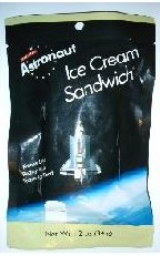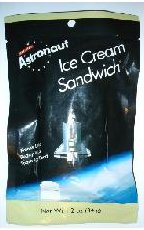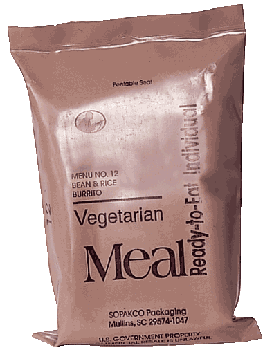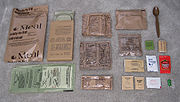
Camping food
Encyclopedia
Backcountry camping food includes ingredients used to prepare food suitable for backcountry camping
and backpacking
. The foods differ substantially from the ingredients found in a typical home kitchen. The primary differences relate to campers' and backpackers' special needs for foods that have appropriate cooking time, perishability, weight, and nutritional content.
 To address these needs, camping food is often made up of either freeze-dried, precooked or dehydrated ingredients. Many campers use a combination of these foods.
To address these needs, camping food is often made up of either freeze-dried, precooked or dehydrated ingredients. Many campers use a combination of these foods.
, however, due to the possibility of a burn-ban being in place, campers do not often rely on this option.
Small amounts of freeze-dried ingredients are sometimes available for sale from emergency supply outlets or from stores specific to camping. Freeze-dried ingredients that have not been combined into a meal are often hard to find, however, and are often sought out by campers.
Full meals or individual ingredients may be dehydrated. Dehydration of individual ingredients allows the flexibility to cook different meals based on available ingredients, while precooked and dehydrated meals offer greater convenience. Several cookbooks and online grocery stores specialize in dehydrated foods. A Fork in the Trail and Another Fork in the Trail are both backcountry cookbooks that focus on dehydrating full meals. For campers wishing to save time, Packit Gourmet is one source that provides dehydrated vegetables for use in camping recipes.

 Surplus military Meals, Ready to Eat (MREs) are sometimes used by campers. These meals contain precooked foods in retort pouch
Surplus military Meals, Ready to Eat (MREs) are sometimes used by campers. These meals contain precooked foods in retort pouch
es. A retort pouch is a plastic and metal foil laminate pouch that is used as an alternative to traditional industrial canning
methods.
 The final type of ingredients available to campers are those that are typically found in the grocery store. Some examples of these types of food are polenta
The final type of ingredients available to campers are those that are typically found in the grocery store. Some examples of these types of food are polenta
, grits
, quick-cooking pasta (such as angel hair pasta), ramen
, instant potatoes, dried soups, jerky and pouch meats such as tuna, SPAM or salmon.
When using these common ingredients, campers often repackage them to reduce packaging or combine them into a meal-ready package, therefore reducing prep-time at camp. The main requirement that campers look for in these types of ingredients is the cook-time with 20 minutes being the longest amount of cook-time that most campers will tolerate.
areas can often have a burn-ban, prohibiting people from starting a fire. If a camper were to rely on the campfire method as their only source for cooking heat, they could find themselves in an unlucky situation. Cooking over a campfire can lead to pots and pans darkened with soot
. Soot can be extremely difficult to remove and, if left on the pan, can easily rub off onto clothing or the inside of the backpack. Campers have discovered methods of preventing this problem, such as coating the pans with cooking oil
, to make the soot easier to remove.
Campers relying on the use of a campfire do not have to carry the extra weight of a cook stove and may rely on a campfire to reduce their pack weight. Campfires provide a great amount of warmth while cook stoves provide none. On cold days, a campfire is often welcome. Leave No Trace
discourages the use of a campfire as a source of heat. Campers making a campfire in the same location time after time can deplete the available wood in the area, which impacts the natural habitat of the animals. Campers are also more likely to inadvertently leave food scraps around the fire pit, which could attract animals.
 Some camping food is ready to eat and may be warmed using chemical heaters, such as the flameless heaters used in MREs, or a self-contained chemical heater built into the food packaging itself.
Some camping food is ready to eat and may be warmed using chemical heaters, such as the flameless heaters used in MREs, or a self-contained chemical heater built into the food packaging itself.
Camping
Camping is an outdoor recreational activity. The participants leave urban areas, their home region, or civilization and enjoy nature while spending one or several nights outdoors, usually at a campsite. Camping may involve the use of a tent, caravan, motorhome, cabin, a primitive structure, or no...
and backpacking
Backpacking (wilderness)
Backpacking combines the activities of hiking and camping for an overnight stay in backcountry wilderness...
. The foods differ substantially from the ingredients found in a typical home kitchen. The primary differences relate to campers' and backpackers' special needs for foods that have appropriate cooking time, perishability, weight, and nutritional content.

Limited cooking time
Due to the difficulty of carrying large amounts of cooking fuel, campers often require their meals to cook in a short amount of time (5–20 minutes). Many campers prefer a ‘just add boiling water’ method of cooking, while others enjoy a more involved, and therefore often higher quality, meal. The amount of cooking time can be disregarded if campers are able to cook over a campfireCampfire
A campfire is a fire lit at a campsite, to serve the following functions: light, warmth, a beacon, a bug and/or apex predator deterrent, to cook, and for a psychological sense of security. In established campgrounds they are usually in a fire ring for safety. Campfires are a popular feature of...
, however, due to the possibility of a burn-ban being in place, campers do not often rely on this option.
Shelf-stablility
Camping foods are often shelf-stable, that is, they require no refrigeration. Campers may be outdoors for days or weeks at a time, and will often pack food for the entire trip. Campers will sometimes take fresh food that can be consumed in the first day or two of a hike but will usually not risk carrying perishable food beyond that timeframe. Campers hiking in the snow or other cold conditions or campers with access to a cold water source may be able to store perishable food in the snow or secured in a bag and kept in the cold water to act as a refrigeration source.Lightweight
Backpackers must carry everything with them so they require all of their gear and food to be as lightweight as possible. Campers often turn to freeze-dried and dehydrated meals and ingredients for this reason, but they will also sometimes take a pouch of tuna or some other ingredient with a high water content with them as a treat, providing that the item has nutritional value.Nutrition content
Backpackers, canoeists, climbers and other outdoor enthusiasts often cover many miles everyday, consuming thousands of calories to keep their energy level high. Backpackers require an average of 480 calories per hour as well as higher sodium levels. To ensure their bodies are properly nourished, campers must pay close attention to their meal plans.Ingredients
To prepare meals that work well outdoors, campers have begun to employ a variety of techniques.Freeze-dried ingredients
Freeze-drying requires the use of heavy machinery and is not something that most campers are able to do on their own. Freeze-dried ingredients are often considered superior to dehydrated ingredients however, because they rehydrate at camp faster and retain more flavor than their dehydrated counterparts. Freeze-dried ingredients take so little time to rehydrate that they can often be eaten without cooking them first and taste something like a crunchy chip.Small amounts of freeze-dried ingredients are sometimes available for sale from emergency supply outlets or from stores specific to camping. Freeze-dried ingredients that have not been combined into a meal are often hard to find, however, and are often sought out by campers.
Dehydrated meals & ingredients
Dehydration can reduce the weight of the food by sixty to ninety percent by removing water through evaporation. Some foods dehydrate well, such as onions, peppers, and tomatoes. Dehydration often produces a more compact, albeit slightly heavier, end result than freeze-drying.Full meals or individual ingredients may be dehydrated. Dehydration of individual ingredients allows the flexibility to cook different meals based on available ingredients, while precooked and dehydrated meals offer greater convenience. Several cookbooks and online grocery stores specialize in dehydrated foods. A Fork in the Trail and Another Fork in the Trail are both backcountry cookbooks that focus on dehydrating full meals. For campers wishing to save time, Packit Gourmet is one source that provides dehydrated vegetables for use in camping recipes.
Precooked foods


Retort pouch
A retort pouch is a type of food packaging created by aseptic processing, made from multiple layers of flexible laminate, allowing for the sterile packaging of a wide variety of food and drink, ranging from water to fully cooked, thermo-stabilized high-caloric meals such as Meals, Ready-to-Eat ...
es. A retort pouch is a plastic and metal foil laminate pouch that is used as an alternative to traditional industrial canning
Canning
Canning is a method of preserving food in which the food contents are processed and sealed in an airtight container. Canning provides a typical shelf life ranging from one to five years, although under specific circumstances a freeze-dried canned product, such as canned, dried lentils, can last as...
methods.
Common ingredients

Polenta
Polenta is a dish made from boiled cornmeal. The word "polenta" is borrowed from Italian.-Description:Polenta is made with ground yellow or white cornmeal , which can be ground coarsely or finely depending on the region and the texture desired.As it is known today, polenta derives from earlier...
, grits
Grits
Grits are a food of American Indian origin common in the Southern United States and mainly eaten at breakfast. They consist of coarsely ground corn, or sometimes alkali-treated corn . They are also sometimes called sofkee or sofkey from the Muskogee language word...
, quick-cooking pasta (such as angel hair pasta), ramen
Ramen
is a Japanese noodle dish. It consists of Chinese-style wheat noodles served in a meat- or fish-based broth, often flavored with soy sauce or miso, and uses toppings such as , , kamaboko, green onions, and occasionally corn...
, instant potatoes, dried soups, jerky and pouch meats such as tuna, SPAM or salmon.
When using these common ingredients, campers often repackage them to reduce packaging or combine them into a meal-ready package, therefore reducing prep-time at camp. The main requirement that campers look for in these types of ingredients is the cook-time with 20 minutes being the longest amount of cook-time that most campers will tolerate.
Camping stoves
There are a large variety of camping stoves on the market ranging in specialty from being extremely lightweight to focusing on using very little fuel. The majority of campers rely on a stove for their cooking needs as they boast several advantages over cooking over a campfire. Since most camping stoves have an adjustable heat source, they can be much easier to use than a campfire. The ability to quickly adjust the flame to reduce your pot from a boil to a simmer, for example, is considered invaluable to many campers. Campfires can take a long time to start and get to a point where they are suitable for cooking over. Since a cook-stove can be ready in minutes, this is an advantage for many campers.Campfire
WildernessWilderness
Wilderness or wildland is a natural environment on Earth that has not been significantly modified by human activity. It may also be defined as: "The most intact, undisturbed wild natural areas left on our planet—those last truly wild places that humans do not control and have not developed with...
areas can often have a burn-ban, prohibiting people from starting a fire. If a camper were to rely on the campfire method as their only source for cooking heat, they could find themselves in an unlucky situation. Cooking over a campfire can lead to pots and pans darkened with soot
Soot
Soot is a general term that refers to impure carbon particles resulting from the incomplete combustion of a hydrocarbon. It is more properly restricted to the product of the gas-phase combustion process but is commonly extended to include the residual pyrolyzed fuel particles such as cenospheres,...
. Soot can be extremely difficult to remove and, if left on the pan, can easily rub off onto clothing or the inside of the backpack. Campers have discovered methods of preventing this problem, such as coating the pans with cooking oil
Cooking oil
Cooking oil is purified fat of plant origin, which is usually liquid at room temperature ....
, to make the soot easier to remove.
Campers relying on the use of a campfire do not have to carry the extra weight of a cook stove and may rely on a campfire to reduce their pack weight. Campfires provide a great amount of warmth while cook stoves provide none. On cold days, a campfire is often welcome. Leave No Trace
Leave No Trace
Leave No Trace is both a set of principles, and an organization that promotes those principles. The principles are designed to assist outdoor enthusiasts with their decisions about how to reduce their impacts when they hike, camp, picnic, snowshoe, run, bike, hunt, paddle, ride horses, fish, ski or...
discourages the use of a campfire as a source of heat. Campers making a campfire in the same location time after time can deplete the available wood in the area, which impacts the natural habitat of the animals. Campers are also more likely to inadvertently leave food scraps around the fire pit, which could attract animals.
Chemical heaters

Further reading
- Claudia Axcell, Vikki Kinmont Kath, Diana Cooke, Simple Foods for the Pack, 3e. Sierra Club

